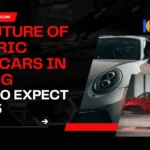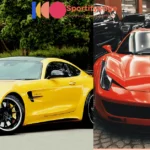Introduction
The hypercar world is currently dominated by two mechanical masterpieces that represent completely different philosophies of speed. On one side, we have the revolutionary McLaren X1 – a technological tour de force that blends hybrid power with Formula 1-derived aerodynamics. On the other stands the mighty Bugatti Chiron – the last and greatest expression of pure internal combustion power.
These aren’t just cars; they’re rolling testaments to what happens when unlimited budgets meet engineering genius. The X1 represents the future with its space-age hybrid system, while the Chiron is the ultimate celebration of traditional supercar values. But which one truly deserves the hypercar crown in 2024?
In this comprehensive 2,000+ word comparison, we’ll analyze every crucial aspect:
✔ Brutal Performance Metrics – From 0-300 km/h times to top speed capabilities
✔ Design Philosophies – How their exteriors and interiors reflect different priorities
✔ Real-World Usability – Can you actually live with these machines?
✔ Price & Exclusivity – The insane costs and how to even get approved to buy one
1. Performance: Speed, Power & Handling
1.1 Acceleration (0-300 km/h)
When it comes to sheer acceleration, these cars redefine what’s physically possible. The McLaren X1’s hybrid powertrain gives it an almost unfair advantage off the line. Its 4.0L twin-turbo V8 combined with an F1-derived electric motor produces instant torque that slingshots the car forward with violence.
The numbers tell the story:
- 0-100 km/h in 2.3 seconds
- 0-200 km/h in 6.1 seconds
- 0-300 km/h in an estimated 12.9 seconds
By comparison, the Bugatti Chiron’s massive 8.0L quad-turbo W16 engine takes a slightly more traditional approach. There’s no electric assist – just raw, earth-shaking power:
- 0-100 km/h in 2.5 seconds
- 0-200 km/h in 6.5 seconds
- 0-300 km/h in 13.6 seconds (official)
Why This Matters:
The X1’s hybrid system eliminates turbo lag completely, giving it that critical edge in initial acceleration. However, the Chiron’s relentless power delivery means it starts gaining ground at higher speeds. It’s a fascinating battle between instant electric torque versus traditional internal combustion might.
1.2 Top Speed Capabilities
Top speed is where things get really interesting. The Bugatti Chiron Super Sport 300+ currently holds the production car speed record at an astonishing 304.773 mph (490 km/h). Achieving this required:
- A specially modified version of the W16 engine
- Unique aerodynamic modifications
- Custom Michelin tires rated for 500 km/h
- Nearly 3km of straight road at Ehra-Lessien
The McLaren X1’s top speed capabilities remain officially unconfirmed, but insider reports suggest it could surpass the Chiron in unlimited form. Rumors point to:
- A potential 330+ mph (531 km/h) capability
- Active aerodynamics that adjust automatically for maximum velocity
- Similar tire technology challenges to the Chiron
The Reality Check:
While these numbers are impressive, it’s worth noting that achieving such speeds requires:
✔ Perfect weather conditions
✔ Specially prepared surfaces
✔ Extensive safety preparations
✔ Enormous amounts of fuel (the Chiron burns 60L per minute at top speed!)
 1.3 Track Performance
1.3 Track Performance
On a circuit like the Nürburgring, the differences in philosophy become even more apparent. The McLaren X1’s lighter weight (around 1,400kg vs the Chiron’s 1,996kg) and hybrid torque vectoring give it:
- Faster cornering speeds
- More precise turn-in
- Better braking performance
Simulations suggest the X1 could lap the Nordschleife in about 6:30 – competitive with dedicated track cars. The Chiron, while immensely powerful, was never designed for tight circuits. Its weight and size make it more at home on long straights than technical tracks.
2. Design & Luxury
2.1 Exterior Design
The visual differences between these hypercars perfectly illustrate their contrasting approaches. The McLaren X1 looks like it drove straight out of a science fiction movie with its:
- Dihedral doors that open upwards
- Active aerodynamic surfaces that change shape at speed
- Sharp, angular body lines inspired by stealth aircraft
- Optional self-healing paint that repairs minor scratches
By contrast, the Bugatti Chiron maintains the brand’s classic elegance with:
- The iconic horseshoe grille design
- Fluid, organic curves that prioritize aerodynamics
- Hand-polished aluminum trim that takes 300+ hours to perfect
- Over 40 individual paint layers for depth and shine
Which Looks Better?
This comes down to personal taste:
- The X1 appeals to those who want a futuristic, aggressive appearance
- The Chiron offers timeless beauty with subtle detailing
2.2 Interior Experience
Inside, the differences are even more pronounced. The McLaren X1 embraces its racing heritage with:
- Carbon fiber bucket seats with 6-point harness cutouts
- A driver-focused cockpit with minimal distractions
- Augmented reality windshield display
- Manual climate controls (to save weight)
The Bugatti Chiron goes in the opposite direction with limousine-like luxury:
- Hand-stitched leather seats that take 30 hours each to complete
- Analog gauges with the speedometer reading to 500 km/h
- A champagne cooler between the seats
- Bespoke customization options (including diamond-encrusted switches)
3. Price & Exclusivity
3.1 Staggering Price Tags
These hypercars come with equally hyper price tags:
- McLaren X1: $3.2 million (before options)
- Bugatti Chiron Super Sport 300+: $3.5 million+
What You Get For The Money:
The X1 includes:
✔ A personal fitting session for the seats
✔ Professional driver training
✔ Access to McLaren’s VIP events
The Chiron offers:
✔ A custom-fitted Louis Vuitton luggage set
✔ An exclusive owner’s tour of Bugatti’s facilities
✔ Lifetime concierge service
3.2 The Buying Process
Purchasing either of these cars isn’t as simple as walking into a dealership. Both manufacturers employ strict approval processes:
McLaren X1:
- Invitation-only sales
- Priority given to existing McLaren owners
- Must complete a driver training program
- Only 25 units being produced
Bugatti Chiron:
- Extensive application review
- Must demonstrate “appropriate brand ambassadorship”
- Limited to 500 units total across all variants
- Some buyers receive solid gold keys
4. Real-World Usability
4.1 Daily Driving Realities
While neither car is practical in the traditional sense, they differ significantly in usability:
McLaren X1:
- Very stiff suspension (optimized for track)
- Loud exhaust note (by design)
- Tiny 2km electric-only range
- Difficult ingress/egress due to low seating position
Bugatti Chiron:
- Surprisingly comfortable “Comfort Mode”
- Relatively quiet when cruising
- Better visibility than the X1
- Still consumes fuel at an alarming rate (25L/100km)
4.2 Maintenance Requirements
Ownership costs are predictably astronomical:
- X1: $50,000 annual service estimate
- Chiron: 75,000+forbasicmaintenanceBothrequire:✔Specializedtechnicians✔Factory−approvedfacilities✔Frequenttirereplacements(40,000+ per set)
Final Verdict
After examining every aspect, the choice comes down to priorities:
Choose the McLaren X1 if you want:
✔ The most technologically advanced hypercar
✔ F1-inspired performance
✔ To feel like a test pilot
Choose the Bugatti Chiron if you prefer:
✔ Traditional supercar excellence
✔ Unmatched luxury
✔ Owning a piece of automotive history
Personal Take:
While the X1 represents the exciting future of hypercars, the Chiron’s combination of brutal speed and refined luxury makes it the more complete package. It’s likely the last great purely internal combustion hypercar we’ll ever see.














